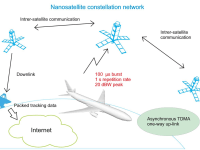After the disappearance of an airliner in midair earlier this year, ICAO organized an exclusive Special Meeting on Global Flight Tracking of Aircraft: “Meeting participants will explore the use of existing technologies that may provide the means to support globally track airline flights at a reasonable cost.” In our view the dedicated satellite tracking link as a vital part of envisioned system must have specific features to differ from existing satellite communication networks that the best way is the dedicated satellite network to be designed from scratch.
The tracker operates independently from embedded avionics and traffic control systems. It is a self-contained and possibly self-powered module mounted on a mobile item such as an aircraft. The module contains a GNSS receiver, MMIS inertial module, microcontroller and burst transmitter providing that uplink. It transmits every second a short 1 Kbit bust. The burst includes identification, time mark, position, velocity vector, acceleration, status and auxiliary information. The collisions randomly occurred due lack of synchronization are not fully recovered but they are not considered critical thanks to the high repetition rate.
The space segment consist of nanosatellite constellation, cross-linked in dedicated communication network. This network receives, process and transfers tracking data flow to the ground station.
The ground station downloads the compressed tracking data from space segment and transfer it to the users interface in real time though Internet gateway.
A number of innovative features have been included in concept development to match challenging requirements toward so small satellite expecting to do so much
Software defined radio (SDR). Fife tracking signal receiver antenna are connected to five low noise preamplifier and fast ADCs. SDR and multiple frontend are applied for bursts collision recovering by means of signal spatial properties.
Modulation techniques. The tracker uplink use spread-spectrum communications approach based on true random sequence encryption for improved data-transfer efficiency and enhanced security compared to traditional systems
Inter-satellite transceiver. Inter-satellite network antenna design is inspired by ATS-B arrangement. It consist of linear array elements placed around a cylindrical surface. Radiation diagram is rotated by phase shift control and beams neighbor satellites in constellation providing dynamic crosslink.
Attitude control. The satellites is spin-stabilized pointed nadir in operational position. Generally, attitude control follows the kinematic schema of Syncom satellite favored for its elegant simplicity. NanoTrack uses magnetorquers and plasma thruster instead of cold gas and hydrogen peroxide jets.
Nanosatellite orbital allocator (NOA). The idea design of orbital allocator is shown on NOA will insert a large number of nano/pico-satellites on predefined orbits and spin attitude and rate preventing initial tumbling.
A low Earth orbit between 550 and 600 km is sorted as an optimal for distributed communication constellation with specific requirements of global tracking. Walker orbit pattern demonstrate increased overlapping in polar zones. To overcome this drawback we propose a second orbit layer with 450 inclination, with best diversity over most traffic intensive zones. Diversity obtained this way will add redundancy and will provides prospect for multilateration as a verification or alternative of pure GPS tracking.
Like this entry?
-
About the Entrant
- Name:Valentin Stavrev
- Type of entry:individual
- Patent status:pending








